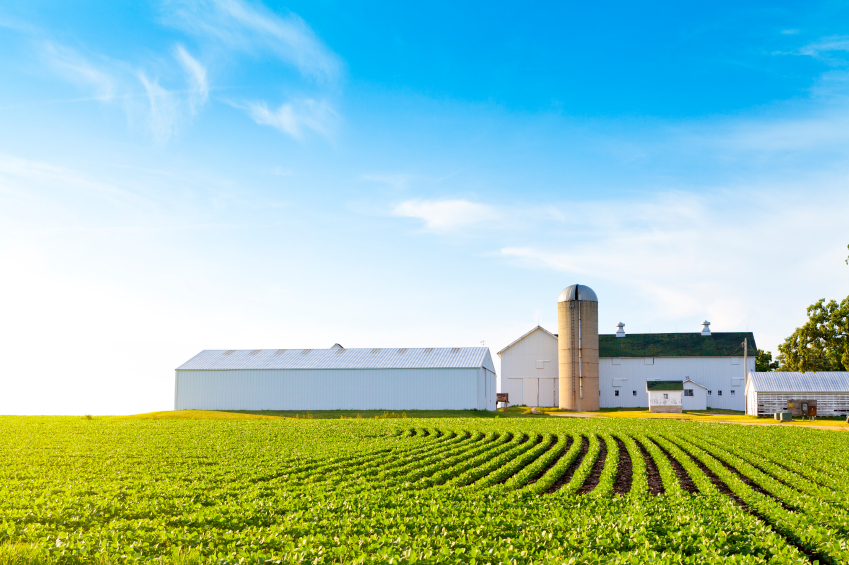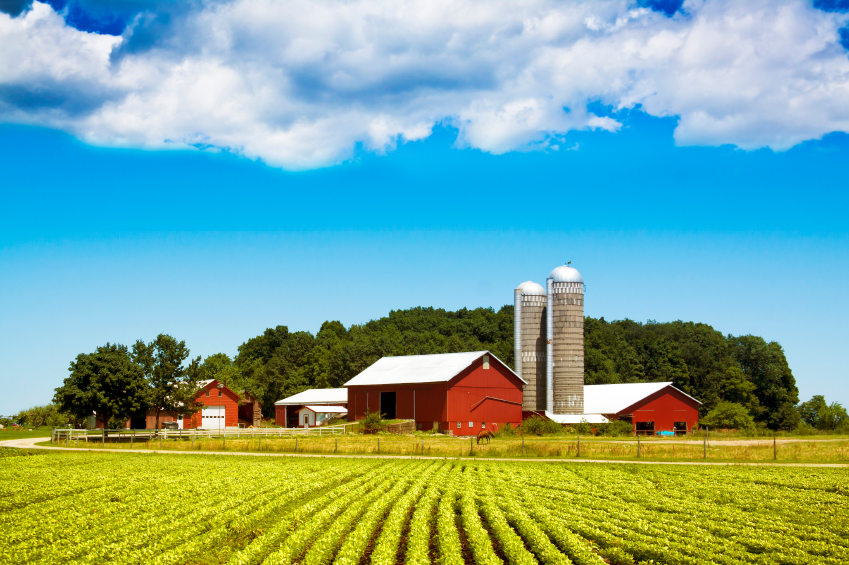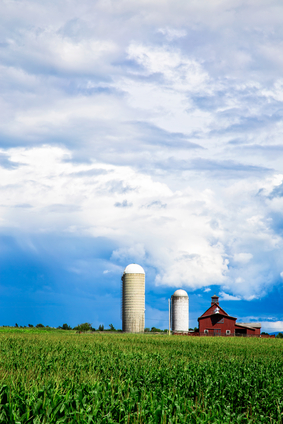New Maintenance Inspection Program
|
|
|
|
|
|
|
|
|
|
|
|
|
|
|
|
 Crop Interseeder Machinery Saves Time and Money
Crop Interseeder Machinery Saves Time and Money As with any other type of industry, time is money on the farm. This is especially true when it comes to putting down cover crops. With grain harvests occurring later each year, many farmers are finding it a challenge to maximize the benefits of a shorter growing season. With cover crops, a farmer can revitalize a field; however, it has to be practical in terms of time and energy spent on the process. This is when interseeding can become a very attractive option.
The concept is simple, in a single pass that incorporates other needed planting functions, interseeder machinery is meant to plant a cover crop, just below the standing crop canopy. When put to the test, researchers at Penn State University (PSU) have discovered that an interseeder tool can simultaneously accomplish three jobs. The best use of the interseeder is for crops that will be planted on 30″ rows. These crops should also incorporate double-disk drill openers that are situated at intervals of 7.5″. While this special planting is going on, farmers can spread postemergence herbicides, in addition to laying down sidedress nitrogen through a high-pressure stream that will float about 4″ above the planting row.
What will all this mean for the average farmers’ bottom line? Those same researchers calculate that anywhere from $20 to $30 an acre can be saved in labor and fuel costs. Thanks to this interseeding process, farmers are able to smoothly plant in fields containing heavy corn residue with a single, efficient machine pass.
Over at Hagie Manufacturing, the design techs have been working diligently on a high-clearance interseeder attachment. To date, the engineers have created two workable systems. The first is an air boom interseeder that has the solution tank swapped out with an 80 cubic feet dry box. The boom is outfitted with specially designed tubing that allows for an even flow just beneath the corn crop canopy. The air boom design can be modified to fit on a 60′ or 90′ boom.
In the second system, the patented Hagie nitrogen toolbar is used with seeding attachments that utilize rolling baskets for the seed. This retrofitted attachment measures around 40′ wide. So far, the researchers have put their machinery to the test by planting high yielding fields of radishes, ryegrass and sudangrass.
The other component required of successful interseeding is to get the timing right. The key is to plant before winter sets in, but not so early as to affect the corn crop. According to the test fields, the best time for interseeders is when corn has hit the V5 growth height (5 – 6 corn leaves with collars).
The researchers have used the interseeder as late as mid-September with very encouraging results. Another major consideration is the specific choice of crop. Varieties of ryegrass and clover have proven to embrace the heat and shade beneath the corn and provide decent fall growth.
Interseeding is just one example of the many agriculture innovations that are helping farmers get the most from their fields. Depending on the area, it may require a little trial and error before you can find the perfect crop cycle. However, the rewards could be substantial, so it is definitely something to investigate further.
 How to Put Vertical Tillage to Work on Your Farm
How to Put Vertical Tillage to Work on Your FarmFarming innovation is all about increasing productivity and making the farmers’ workday a bit smoother. This is how the concept of vertical tillage was formed. Basically, vertical tillage allows the farmer to start a field’s drying out phase earlier. It can also provide more residue on the soil while creating a smoother seedbed. Farmers who have used vertical tillage appreciate the ability to run fast and pull shallow. This process is changing the way many crops are being grown and how fields are being cleared. The key is to find the right tool for your fields.
The average vertical tillage tool is designed with straight blades that cut residue at a rate of up to 9 mph. When the tool is set to run 2 inches deep, you’ll be breaking down enough crop residue in the fall, to set the course for drying out the soil when the weather becomes warmer. Because of the speed of the vertical tillage tool, many farmers are able to work through a field faster than they did before.
These tools have been shown to work exceptionally well in cornfields where the residue breakdown of the fall season crop is so important. In the spring, farmers have found an additional benefit from running their vertical tillage tool before the planter; it causes the crop residue to get fluffed up and brings the rich soil to the top layer. The result is an improved seed-to-soil configuration. Soybean farmers have discovered that running the vertical tillage tool in the spring really warms up the soil and this has allowed these crops to grow quickly.
Agronomists who have studied the benefits of vertical tillage have discovered that the overall health and structure of the soil has improved greatly in the fields where this method is deployed. This is due to the fact that the vertical tillage tools on the market today, avoid the concave angle of the traditional tilling blades. Because it doesn’t shift the soil from side to side, vertical tillage helps the farmer avoid the horizontal pans that many growers are trying to avoid. The typical method of tilling is to run a ripper in the fall and a cultivator in the spring. The result was that the cultivator was digging into 3 inches of soil that ended up compacting the area. Vertical tillage sidesteps the compaction issue.
A brand new vertical tillage tool can run as high as $50,000 for a standalone unit. However, there are many ways that pieces of equipment like the Landoll Tilloll can be retrofitted with rolling coulters. The total cost is closer to $8,000.
Is vertical tillage right for your farm? That might come down to the matter of your yield-limiting issues. Farmers who are constricted by the wrong hybrid, phosphorus or potassium levels might find that vertical tillage isn’t the solution. Instead, it is recommended that you first analyze your roots to determine what could be holding back your yield.
Making an informed decision about switching over to vertical tillage will offer the most rewards for your harvest.
 Farm Drones Flying to a Field Near You
Farm Drones Flying to a Field Near YouRecently, the online shopping giant Amazon announced that they were working on drone delivery. The goal is to have any order placed with Amazon delivered within 30 minutes via a fully automated drone. In response to this news, the small community of Deer Trail, Colorado put forth a ballot measure that would allow hunters to shoot down government drones. No word yet on the ability to tell the difference between a government drone and an Amazon drone.
Of course, those two entities aren’t the only players in the drone game. On the horizon in industrial agriculture, there is the potential for farmers to put drones to use over their fields. This could prove to be a major benefit in the agricultural and drone manufacturing industry.
A Future of Drones
Right now, most of the drones in use have military or security applications. A drone can be equipped with a video camera, lights, microphones and even a robotic arm. Best of all, it doesn’t take a lot to operate the drone; typically, a single pilot can maneuver the drone from the safety of a far away bunker. In the future, drones will be fully automated with downloadable flight plans that would allow them to fly and function without a pilot. But, the question is, how can this technology help farmers?
Thanks to improved automation systems, the modern farm requires fewer workers to tend to the thousands of acres on a single property. While that is good news for the farmer’s bottom line, this is not favorable when it comes to crop management. It’s difficult to manage such a large area and keep track of any problems that could happen. However, with the development of automated drones, managing vast tracts of farmland would become easier. A flyover from an automated drone could help inspect the plants and detect any infestation or disease.
Drones are already being used by farmers to collect all kinds of data about plant growth and soil conditions. It’s not a stretch to imagine the basic operational systems of these drones being expanded to perform an even larger array of tasks.
Protecting the Farm
Agricultural drones are being developed to protect farms from potentially devastating infestations such as birds, diseases and bugs. This next generation of drones will not only be able to detect these swarms, but will also be able to deliver remedies such as pesticides and herbicides. Think of them as robotic crop dusters. These same drones could be adapted to deliver warming foam when the falling temperatures threaten crops. The mere presence of a flying drone will likely be enough to scare off flocks of birds. This means that the drone could also be thought of as the ultimate “scarecrow.”
Seeding the Land
Over in Japan, scientists are far ahead when it comes to drone technology, developing robots with the ability to plant rice crops. Here in America, GPS equipped tractors are helping farmers plant perfectly aligned fields of wheat. Therefore, the idea that sometime in the near future you’ll be seeing drones seeding fields as you drive in the country side, isn’t all that farfetched.
According to a survey conducted by Unmanned Vehicle Systems International, by the year 2025, the drone industry could pump 100,000 new jobs and $82 billion into our economy. The more help a farmer can receive for improved production and yield, the better off we’ll all be.
So keep watching the skies; there could be a drone flying over.
 As technology advances, farmers are stepping up to take advantage of all the new equipment and applications. For farmers, a tablet makes for a handy device. Its size makes it more practical than a Smartphone, yet easier to carry around than a laptop. With a tablet, a farmer can tap into all kinds of valuable resources and current information. They’ll be able to get up to date weather reports and trending farm prices. The issue might not be, “does a farmer need a tablet?” but rather “which tablet should they buy?”
As technology advances, farmers are stepping up to take advantage of all the new equipment and applications. For farmers, a tablet makes for a handy device. Its size makes it more practical than a Smartphone, yet easier to carry around than a laptop. With a tablet, a farmer can tap into all kinds of valuable resources and current information. They’ll be able to get up to date weather reports and trending farm prices. The issue might not be, “does a farmer need a tablet?” but rather “which tablet should they buy?”
There are many styles of tablets to pick from; the differences mainly come down to the operating systems. Here you’ll have three options: Windows, iOS or Android. Before choosing your tablet, look into which operating system works best for your circumstances. Continue reading to see the differences between the various options between tablets for farmers.
Apple iOS
iOS is the operating system used exclusively on all Apple products including the iPad. For someone who is already using an iPhone, adapting to the iPad is a snap. The exact same features, apps, and systems are used across both platforms.
The iPad Air sells for $499. That is for a Wi-Fi only unit with 16 GB of memory. It’s a very smooth system to operate, with few complaints from its legion of users. It is especially adept at loading desktop-only websites, an important feature for any work related sites you hope to use while on the job.
Because of the “competition factor,” you won’t be able to load Microsoft Office onto your iPad. However, there is a wide range of work-around apps that can deliver the exact same capacity of creating and editing documents. Best of all, when you email those documents they are automatically converted to a Word file. iPad is also the top selling tablet out there; this means you’re sure to find other iPad users and a wide range of online forums and websites that can provide helpful hints. Of course, there is always the “genius bar” standing by to offer support.
Windows 8
If you’re already a big fan of Microsoft products, then it makes sense to stick with the Windows operating system for your tablet choice. Although the touch screens look a lot like the Apple and Android pads, you’ll find that you’ll be able to upload and adapt your Microsoft Office programs rather effortlessly. This means you can utilize Outlook, Word, and Excel from any Wi-Fi hotspot. There are also hundreds of applications available in the online Windows Store that can be of huge benefit for the working farmer.
The most popular Windows tablet is their Microsoft Surface 2 model, which comes fully loaded with Microsoft Office. The Surface Pro 2 edition of the tablet is the next step up in technology and price. It can serve as a de facto laptop, but is double the price of the Surface 2.
Android
Google, the world’s leading search engine, has gotten into the tablet game with its Android operating system. You’ll find this operating system being used on tablets manufactured by Samsung and Asus. Android is considered an open source type of software. This means that certain manufacturers can produce an inferior tablet model and load it with Android. This puts them in the tablet arena, but means you need to do your research so you don’t select a lower end device. This is why you should be wary of Android tablets selling for under $200. The best pick for Android is the Samsung Note 10.1 tablet. A favorite feature of this table is the S Pen which lets you write out a note with the stylus pen, then converts your writing into a text. You’ll also find a decent lineup of apps to use with this system.
If you’re buying a farmer a tablet as a gift, see if they are already using certain apps on their Smartphone or computer. You’ll want to make sure you gift them with a tablet that supports those apps. This will ensure that your farmer friend won’t have any complications putting their new tablet to work. Whatever system you go with, for yourself or for a friend, you can be certain that the many features of a tablet will be beneficial and helpful for work; while the convenience and variety of apps will make for plenty of fun.
The Sight and Hearing Association of Minnesota has found that hearing loss can occur from chronic overexposure to loud noise. Noise fatigue is a workplace hazard for many occupations, including farming.
According to several university studies and research compiled by the U.S. Center for Disease Control and Prevention, up to 75% of all farmers experience some form of work-related noise fatigue and hearing loss. Although mining comes in at number one, farming would be towards the top of the list when it comes to occupations that have a high risk of causing hearing loss.
Here are some of the symptoms to be aware of with hearing loss:
Hearing loss is often progressive. This means that farmers exposed to persistent, intense noise could feel the affected of damage later in life. For example, despite upgrading to noise reducing machinery such as cab tractors, hearing loss could still occur due to past exposure. Unfortunately, many farmers feel that the only loud noises they come in to contact with are from the tractors. This is not the case; throughout the day, a farmer is exposed to a variety of noises that could lead to damage.
How loud is too loud? A general rule of thumb is that if you have to raise your voice over the noise of a machine to talk to someone who is just a few feet away, then the machine noise could be at a damaging level. The accepted level of work related noise is 85 decibels; anything louder than this and protective gear should be used to prevent hearing damage.
How do farm noises rate? Consider these decibel levels:
Clearly, there isn’t a lot going on during the course of an average workday on the farm that wouldn’t require the need for noise protection. There are many types of protective gear available on the market including noise reduction headphones to ear buds; even small earplugs will provide some level of noise dampening. In order to follow through on using them when needed, the best choice is something you feel comfortable wearing.
Whatever type of safety gear you select, consider purchasing several pairs. By having multiple sets spread across your machinery, you are more likely to remember to use them. Whenever possible, try to go from a noisy environment to a quiet zone to give your ears a rest. The harsh reality is that the hearing loss from the persistent noises that come with the job, is irreversible. Not even hearing aids or surgery can make up for the loss; however, that doesn’t mean you cannot slow down the progression. It is vital that you wear protective hearing gear at all times, your hearing should not be taken for granted.
 Are Your Silos Ready for Your Corn?
Are Your Silos Ready for Your Corn?Are your silos ready for corn storage? It seems that every couple of months there is a bacteria breakout that sends folks to the hospital and causes major headaches for food producers. Among the common culprits of these outbreaks are contaminated lettuce and beef. There isn’t a lot of discussion about corn bacteria, but that could change with this coming harvest. Because of a dip in prices, more farmers are opting to store their corn in the hopes that the value will pick up in the coming months. This is when farmers need to be aware of mycotoxin contamination.
Typically, corn will go into a storage unit retaining 14 percent of its moisture content. However, that content can waver anywhere between 13 and 20 percent. This puts the responsibility squarely on the farmers’ shoulders to monitor the temperature of those silos and stay on top of the moisture levels. Being lax in this regard can lead to swatches of corn that become infected with Penicillium mycotoxins. When left unchecked, a small zone of infected corn can quickly spread through the entire harvest.
Recently, Alltech conducted its yearly Harvest Analysis North America. For the survey, 10 samples of corn and corn silage were collected from Canadian and American farms. According to the results, all of the samples tested positive for multiple mycotoxins; in spite of record rainfalls in these corn producing areas. This has shifted the debate from “will contamination happen?” to “how to control the contamination?”
Many of the American corn samples were taken from the Corn Belt region (located in the Midwestern United States), crops which end up as feed for the major dairy producers. According to the results of the Alltech survey, it would seem that mycotoxin contamination is on par to match the same levels as last year. The zones with the most reported corn silage contamination are found in the Mid-Atlantic, Northeast, and Upper Midwest. Among the strains of mycotoxin, the most dominant is Fumonisin. The second and third most prominent strains are Fusaric Acid and Type B Trichothecenes.
In the case of Type B Trichothecenes, many of the farmers have deemed the low levels to be of little risk to the crop. This is all part of the process that every farmer goes through as they asses quality over quantity.
Here are some helpful storage points to keep in mind:
A little due diligence will go a long way towards protecting your harvest.
Back in the day, farmers would use time-tested skills to bring in the herds and harvest the crops. Today, the modern farmer is given a powerful boost by some very high-tech gadgets. When the laptops, GPS and WiFi are working properly, they can be a huge help in tracking crop yields and predicting future growth patterns. However, all it takes is a single frozen display screen to bring your work to a screeching halt. As tempting as it might be to toss that computer into the combine, there are some simple computer hacks you can perform to get your computer back up and running.
Write Down Your Error Codes
A computer that refuses to boot up could present an error code on your start up screen. Jot down the error code for reference. Next, check your owner’s manual to find a troubleshoot fix related to that error code. If you have access to a second computer, do a Google search for the error code; between customer support sites and many computer users taking to forums to share solutions to computer questions and problems, chances are you will be able to find some helpful tips and tricks.
Write Down Your Calibration Values
Just because you enter data on a computer, that does not mean you shouldn’t have a hard copy of your information. Keep a record of any calibrations that might pertain to your yield monitors, acre counters or any other information that you need to enter into a program. Although they may help your computer system, some of the fixes you may need to perform could erase all of your stored data. If you have a notepad with the numbers you’ll be able to reenter your data, instead of having to start from scratch.
Forced Restart
When your computer freezes (it happens to everyone), try a forced restart. After turning off the computer, wait a full minute before restarting. This will give your system a chance to fully reboot and reconfigure. Hopefully, this will be the only fix you’ll need.
Power Down
If the forced restart of the computer doesn’t work, try powering down completely by turning off your tractor and unplugging the display. After 60 seconds, plug everything back in and restart. If there is still a problem you may want to try a cold boot. For this hack, you’ll need to shut down all power. That could mean disabling the tractor’s battery cable to remove any possibility of electrical power feeding into your unit.
Call For Help
If all of these reboot measures have failed, it’s time to call a service technician. Depending on the problem, they might be able to guide you through a solution over the phone, but when all else fails, bring in the service tech and let them work their magic.
Always Back Up
This is a lesson most people learn too late. You should get into the habit of backing up your data on a regular basis. Most systems allow for a regular backup and you can also make copies of your data onto a flash drive. This way in extreme failures, you’ll always have your data ready to reload in to a new system.